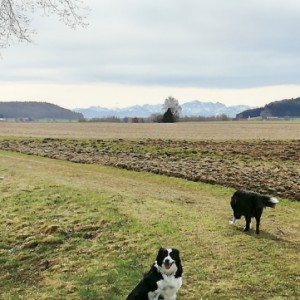Kittel
Fans of Kate Greenaway may have a bit of an idea what a Kittel or Kittelschürze is. But even her images can't convey the importance of this garment in German culture.
It's more than an apron simply used for cooking but almost a "uniform" worn by women from getting up in the morning until they had completed the days work. It would also be removed if one was to leave the immediate neighbourhood to say go shopping or go to church or if visitors turned up for afternoon tea.
It was safety clothing, more than an apron, usually a long knee-length, sleeveless shirt type garment with buttons down the front and two outer pockets at hip height. No apron strings that could get tangled in machines. It was designed to protect one's clothing from everything the daily chores around the house could throw at you - from the fat at the oven, to the collecting of firewood, the emptying of ashes, the dirt from plucking the goose or peeling the potatoes, the splashes from the mop etc.
I don't know when it first came in to use, but I guess it had its heyday in post-WWII Germany and up until the early 70's and still to this day has its followers particularly in the more rural areas. No doubt originally out of flax/linen, then cotton and in the 60s & 70s out of nylon. The former East Germany (DDR) relied heavily on exports of nylon Kittels to West Germany in the 70's for foreign exchange. The DDR got cheap petroleum products from the USSR and with their large petrochemical works and cheap labour, they produced them by the million.
In one particular action in the 1970's, the DDR sold 10 million in a deal with the West German catalogue shop concern "Quelle" who packaged them in sets of 3 and sold them for DM 9.99 and sold out within a few weeks. Quelle had paid "penny" amounts for each garment and made sales of 30 million DM.
For someone of my generation, it is not possible to recall a German Grandmother without seeing her in such a garment, but I suspect even many of today's teenagers have such memories. In a village like ours, I would still expect many to wear one.
In Germany and in particular the alpine regions you will also see men wearing something similar and with the same name. Almost always blue in colour and somewhat heavier. Usually farmers standard wear for work in the cow stables but also for general tasks around the farm - making firewood etc. In rural parts of the UK, the smock was also often worn by men in agriculture.
I happened to see this display of old Kittels and aprons in the county council offices in Mindelheim, a project of a few local artists. Entitled:
"An Hommage to our Mothers and Grandmothers"
Memories of women who often knew nothing other than working, never laid their hands in their laps, as a matter of course suffered often without being given a word of thanks or appreciation. What dreams and wishes would these women have had?
And underneath each of the Kittels is a photo of the owner's environment, their name, age and a thought:
Afra, 82, dreamed of a better life
Sofie, 91, always had to work hard.
Josefa, 85, was always very thrifty
Cilli, 87, raised nine children
Rosa, 75, could heal with herbs
Karoline, 90, was not allowed to marry
Agathe, 79, never saw the sea
I found the display very moving.
Having done my business there went for a glorious walk with the dogs just a kilometre south of Mindelheim with a superb view to the snow covered Alps. It was warm and clouds were building but luckily disappeared not long after. Even Flash enjoyed the new walk - he is often very reluctant to try out new walks, and it's part of the reason why the daily walks have become somewhat boring - he has about half a dozen that he approves of and are of the length that he can cope with. The days of exploring new tracks have long gone.
The Extra photo shows the scene and as so often in the past two years, reminded me of the suffering of the ever so brave, wonderful 40-year-old Pep in Hampshire, who finally succumbed to Myeloma last autumn. The Alps were our constant "theme" in our social network "relationship". A girl of exceptional, selfless courage and inspiration to hundreds of fellow sufferers and their families. Pep would never have worn a Kittel, but she would have liked the main Blip.
On the subject of Myeloma, I recently came in to contact with a friend who I haven't had contact with for about 30 years. Her partner is currently fighting his war against Myeloma at Addenbrookes. I must check up on progress
One of the most important people in my life whose husband is fighting Myeloma successfully is about to have her birthday so must send off a card. Can't lay my hands on a Kate Greenaway or a Swedish Carl Larrson print that Annie would like. So maybe a teddy bear in memory of a large Paddington I once gave her.
The Geo-position is where we did our walk. Just behind us was the 13th Century Mindelburg castle overlooking Mindelheim which John Churchill, Duke of Marlborough was given in 1706 following the War of the Spanish Succession. Back then the Bavarians were on the side of the French fighting against the Holy Roman Empire, the Austrians, the Dutch, the Portuguese and the British. Lots of history around here.


Comments New comments are not currently accepted on this journal.